
Grisette (French)
Encyclopedia
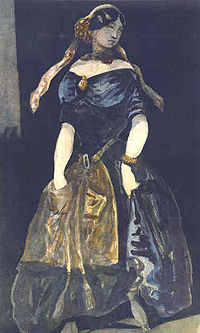
France
The French Republic , The French Republic , The French Republic , (commonly known as France , is a unitary semi-presidential republic in Western Europe with several overseas territories and islands located on other continents and in the Indian, Pacific, and Atlantic oceans. Metropolitan France...
working-class woman from the late 17th century and remained in common use through the Belle Époque
Belle Époque
The Belle Époque or La Belle Époque was a period in European social history that began during the late 19th century and lasted until World War I. Occurring during the era of the French Third Republic and the German Empire, it was a period characterised by optimism and new technological and medical...
era, albeit with some modifications to its meaning. It derives from gris, (French
French language
French is a Romance language spoken as a first language in France, the Romandy region in Switzerland, Wallonia and Brussels in Belgium, Monaco, the regions of Quebec and Acadia in Canada, and by various communities elsewhere. Second-language speakers of French are distributed throughout many parts...
for grey), and refers to the cheap grey fabric of the dresses these women originally wore. The 1694 edition of the Dictionnaire de l'Académie française
Dictionnaire de l'Académie française
The Dictionnaire de l'Académie française is the official dictionary of the French language.The Académie française is France's official authority on the usages, vocabulary, and grammar of the French language, although its recommendations carry no legal power...
described a grisette as simply "a woman of lowly condition". By the 1835 edition of the dictionary, her status had risen somewhat. She was described as:
"a young working woman who is coquettish and flirtatious."This usage can be seen in one of Oliver Wendell Holmes'
Oliver Wendell Holmes, Sr.
Oliver Wendell Holmes, Sr. was an American physician, professor, lecturer, and author. Regarded by his peers as one of the best writers of the 19th century, he is considered a member of the Fireside Poets. His most famous prose works are the "Breakfast-Table" series, which began with The Autocrat...
early poems 'Our Yankee Girls' (1830):
"the gay grisette, whose fingers touch love's thousand chords so well...".In practice, "young working woman" referred primarily to those employed in the garment and millinery trades as seamstresses or shop assistants, the few occupations open to them in 19th century urban France, apart from domestic service. The sexual connotations which had long accompanied the word are made explicit in Webster's Third New International Dictionary (1976) which lists one of its meanings as a young woman who combines part-time prostitution with another occupation. Webster's quotes an example from Henry Seidel Canby
Henry Seidel Canby
Henry Seidel Canby was a critic, editor, and Yale University professor.Canby was born in Wilmington, Delaware and attended Wilmington Friends School...
's 1943 biography of Walt Whitman
Walt Whitman
Walter "Walt" Whitman was an American poet, essayist and journalist. A humanist, he was a part of the transition between transcendentalism and realism, incorporating both views in his works. Whitman is among the most influential poets in the American canon, often called the father of free verse...
:
"and many years later [Whitman] was still talking to Traubel of the charm of the dusky grisettes who sold love as well as flowers on the streets of New Orleans."
The 18th century grisette
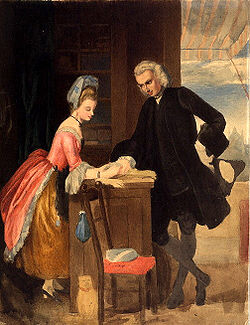
Jonathan Swift
Jonathan Swift was an Irish satirist, essayist, political pamphleteer , poet and cleric who became Dean of St...
was already using grisette in English to signify qualities of both flirtatiousness and intellectual aspiration. (See The grisette in poetry below.) The grisette also makes an appearance in Lawrence Sterne's 1768 novel A Sentimental Journey Through France and Italy
A Sentimental Journey Through France and Italy
A Sentimental Journey Through France and Italy is a novel by the Irish-born English author Laurence Sterne, written and first published in 1768, as Sterne was facing death. In 1765, Sterne travelled through France and Italy as far south as Naples, and after returning determined to describe his...
. In Chapter II of the novel, the Reverend Mr. Yorick (the narrator and Sterne's alter ego) recounts his obsessions with Parisian grisettes, and especially with a particularly beautiful one who worked in a Paris glove shop:
- "The beautiful grisette looked sometimes at the gloves, then sideways to the window, then at the gloves, and then at me. I was not disposed to break silence. I followed her example: so, I looked at the gloves, then to the window, then at the gloves, and then at her, and so on alternately. I found I lost considerably in every attack: she had a quick black eye, and shot through two such long and silken eyelashes with such penetration, that she look'd into my very heart and reins. It may seem strange, but I could actually feel she did."
One of the most famous grisettes of the 18th century was Madame du Barry
Madame du Barry
Jeanne Bécu, comtesse du Barry was the last Maîtresse-en-titre of Louis XV of France and one of the victims of the Reign of Terror during the French Revolution.-Early life:...
(1743–1793). However, she soon rose well beyond her initial social status. The illegitimate daughter of a seamstress, she had moved to Paris at the age of 15, where, using the name Jeanne Rancon, she worked first as an assistant to a young hairdresser with whom she had an affair and later as a milliner's assistant in a shop named A La Toilette. In 1763, her beauty came to the attention of Jean du Barry, a fashionable pimp/procurer and casino owner. He made her his mistress and helped establish her career as a courtesan
Courtesan
A courtesan was originally a female courtier, which means a person who attends the court of a monarch or other powerful person.In feudal society, the court was the centre of government as well as the residence of the monarch, and social and political life were often completely mixed together...
in the highest circles of Parisian society, where she took several wealthy men as her 'benefactors', including the Duke of Richelieu
Louis François Armand du Plessis, duc de Richelieu
Armand de Vignerot du Plessis was a French soldier, diplomat and statesman. Joining the army, he participated in three major wars and eventually rose to the rank of Marshal of France....
. On her marriage to du Barry's brother, she became Marie-Jeanne, Comtesse du Barry, and in April of 1769 she became the official mistress (maîtresse declarée or maîtresse en titre) of King Louis XV of France
Louis XV of France
Louis XV was a Bourbon monarch who ruled as King of France and of Navarre from 1 September 1715 until his death. He succeeded his great-grandfather at the age of five, his first cousin Philippe II, Duke of Orléans, served as Regent of the kingdom until Louis's majority in 1723...
.
The grisette in Parisian bohemia
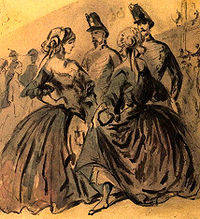
Bohemianism
Bohemianism is the practice of an unconventional lifestyle, often in the company of like-minded people, with few permanent ties, involving musical, artistic or literary pursuits...
artistic and cultural venues in Paris. They formed relationships with artists and poets more committed than prostitution
Prostitution
Prostitution is the act or practice of providing sexual services to another person in return for payment. The person who receives payment for sexual services is called a prostitute and the person who receives such services is known by a multitude of terms, including a "john". Prostitution is one of...
but less so than a mistress
Mistress (lover)
A mistress is a long-term female lover and companion who is not married to her partner; the term is used especially when her partner is married. The relationship generally is stable and at least semi-permanent; however, the couple does not live together openly. Also the relationship is usually,...
. Many grisettes worked as artist's models, often providing sexual favours to the artists in addition to posing for them. During the time of King Louis-Philippe
Louis-Philippe of France
Louis Philippe I was King of the French from 1830 to 1848 in what was known as the July Monarchy. His father was a duke who supported the French Revolution but was nevertheless guillotined. Louis Philippe fled France as a young man and spent 21 years in exile, including considerable time in the...
they came to dominate the bohemian modelling scene. Although the grisette models were perceived to be adventurous, independent, and living only for moment, they sought not only economic support, but also emotional and artistic support in their relationships with bohemian men. Jenny whose story is recounted by Jules Janin
Jules Janin
Jules Gabriel Janin was a French writer and critic.-Biography:Born in Saint-Étienne , Janin's father was a lawyer, and he was educated first at St. Étienne, and then at the lycée Louis-le-Grand in Paris...
in his essay "La Grisette" is a prototypical grisette in this sense, initially choosing to model only for artists whom she considers geniuses and declining more lucrative offers to become the lover of bourgeois or even aristocratic men. Janin considered the grisettes an integral part of the bohemian artistic scene, but viewed their sexual mores somewhat negatively and suggests that their independence was only superficial:
"Art is the grand excuse for all actions that are beyond vulgar. It is art that purifies everything, even a poor young woman's submission of her body."
The grisette as part of the bohemian sub-culture was a frequent character in French fiction of the time. She is personified as Rigolette in Eugene Sue
Eugène Sue
Joseph Marie Eugène Sue was a French novelist.He was born in Paris, the son of a distinguished surgeon in Napoleon's army, and is said to have had the Empress Joséphine for godmother. Sue himself acted as surgeon both in the Spanish campaign undertaken by France in 1823 and at the Battle of Navarino...
’s The Mysteries of Paris
Les Mystères de Paris
The Mysteries of Paris is a novel by Eugène Sue which was published serially in Journal des débats from June 19, 1842 until October 15, 1843. Les Mystères de Paris singlehandedly increased the circulation of Journal des débats...
, as Fantine in Victor Hugo
Victor Hugo
Victor-Marie Hugo was a Frenchpoet, playwright, novelist, essayist, visual artist, statesman, human rights activist and exponent of the Romantic movement in France....
’s Les Misérables
Les Misérables
Les Misérables , translated variously from the French as The Miserable Ones, The Wretched, The Poor Ones, The Wretched Poor, or The Victims), is an 1862 French novel by author Victor Hugo and is widely considered one of the greatest novels of the nineteenth century...
and Marthe in George Sand
George Sand
Amantine Lucile Aurore Dupin, later Baroness Dudevant , best known by her pseudonym George Sand , was a French novelist and memoirist.-Life:...
's Horace, as well as in the protagonist in Alfred de Musset
Alfred de Musset
Alfred Louis Charles de Musset-Pathay was a French dramatist, poet, and novelist.Along with his poetry, he is known for writing La Confession d'un enfant du siècle from 1836.-Biography:Musset was born on 11 December 1810 in Paris...
’s Mademoiselle Mimi Pinson: Profil de grisette. Notable examples in British and American fiction are Trilby in George Du Maurier
George du Maurier
George Louis Palmella Busson du Maurier was a French-born British cartoonist and author, known for his cartoons in Punch and also for his novel Trilby. He was the father of actor Gerald du Maurier and grandfather of the writers Angela du Maurier and Dame Daphne du Maurier...
's novel of the same name, and Marie in Edgar Allan Poe's
Edgar Allan Poe
Edgar Allan Poe was an American author, poet, editor and literary critic, considered part of the American Romantic Movement. Best known for his tales of mystery and the macabre, Poe was one of the earliest American practitioners of the short story and is considered the inventor of the detective...
short story "The Mystery of Marie Roget
The Mystery of Marie Roget
"The Mystery of Marie Rogêt", often subtitled A Sequel to "The Murders in the Rue Morgue", is a short story by Edgar Allan Poe written in 1842. This is the first murder mystery based on the details of a real crime. It first appeared in Snowden's Ladies' Companion in three installments, November and...
". Du Maurier based large parts of Trilby
Trilby (novel)
Trilby is a novel by George du Maurier and one of the most popular novels of its time, perhaps the second best selling novel of the Fin de siècle after Bram Stoker's Dracula. Published serially in Harper's Monthly in 1894, it was published in book form in 1895 and sold 200,000 copies in the United...
on his experiences as a student in Parisian bohemia during the 1850s. Poe's 1842 story was based on the unsolved murder of Mary Cecilia Rogers
Mary Rogers
Mary Cecilia Rogers , also known as the "Beautiful Cigar Girl", was a 19th-century murder victim whose story became a national sensation in the United States...
near New York City. Poe translated the setting to Paris and Mary Rogers to a young grisette, Marie Roget. Subtitled "A Sequel to 'The Murders in the Rue Morgue
The Murders in the Rue Morgue
"The Murders in the Rue Morgue" is a short story by Edgar Allan Poe published in Graham's Magazine in 1841. It has been claimed as the first detective story; Poe referred to it as one of his "tales of ratiocination". Two works that share some similarities predate Poe's stories, including Das...
'", it was the first detective story to attempt the solution of a real crime. Possibly the most enduring grisette of all is Mimi in Henri Murger
Henri Murger
Louis-Henri Murger, also known as Henri Murger and Henry Murger was a French novelist and poet....
’s novel (and subsequent play) Scènes de la vie de Bohème, the source for Puccini's famous opera La bohème.
Grisettes in opera, musical theatre and song
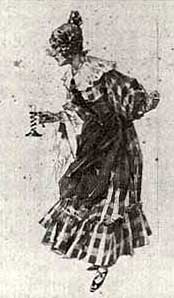
- Mimi Pinson 1882 – musical by Gustave Michiels, Maurice Ordonneau, Arthur Verneuil, adapted from de Musset's short story, Mademoiselle Mimi Pinson: Profil de grisette.
- Mimì and Musetta in La bohèmeLa bohèmeLa bohème is an opera in four acts,Puccini called the divisions quadro, a tableau or "image", rather than atto . by Giacomo Puccini to an Italian libretto by Luigi Illica and Giuseppe Giacosa, based on Scènes de la vie de bohème by Henri Murger...
1896 – operaOperaOpera is an art form in which singers and musicians perform a dramatic work combining text and musical score, usually in a theatrical setting. Opera incorporates many of the elements of spoken theatre, such as acting, scenery, and costumes and sometimes includes dance...
by Giacomo PucciniGiacomo PucciniGiacomo Antonio Domenico Michele Secondo Maria Puccini was an Italian composer whose operas, including La bohème, Tosca, Madama Butterfly, and Turandot, are among the most frequently performed in the standard repertoire...
, adapted from Murger’s novel Scènes de la vie de Bohème. - Mimì and Musetta in La bohèmeLa bohème (Leoncavallo)La bohème is an Italian opera in four acts, with music and libretto by Ruggero Leoncavallo, based on Scènes de la vie de bohème by Henri Murger. The opera received its premiere at the Teatro la Fenice, Venice on May 6, 1897....
1897 – opera by Ruggiero Leoncavallo, likewise adapted from Murger’s Scènes de la vie de Bohème. A revised version of this opera, which gave a much bigger role to Mimì premiered in 1913 with the title Mimì Pinson. - The Gay Grisette 1898 – musical by Carl Kiefert and George DanceGeorge Dance (dramatist)George Dance was an English lyricist and librettist in the 1890s and an important theatrical manager at the beginning of the 20th century....
.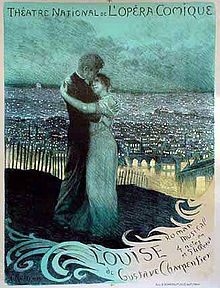
- Louise in LouiseLouise (opera)Louise is an opera in four acts by Gustave Charpentier to an original French libretto by the composer, with some contributions by Saint-Pol-Roux, a symbolist poet and inspiration of the surrealists....
1900 – opera by Gustave CharpentierGustave CharpentierGustave Charpentier, , born in Dieuze, Moselle on 25 June 1860, died Paris, 18 February 1956) was a French composer, best known for his opera Louise.-Life and career:...
. - Magda in La RondineLa rondineLa rondine is an opera in three acts by Giacomo Puccini to an Italian libretto by Giuseppe Adami, based on a libretto by Alfred Maria Willner and Heinz Reichert...
1917 – operaOperaOpera is an art form in which singers and musicians perform a dramatic work combining text and musical score, usually in a theatrical setting. Opera incorporates many of the elements of spoken theatre, such as acting, scenery, and costumes and sometimes includes dance...
by Giacomo PucciniGiacomo PucciniGiacomo Antonio Domenico Michele Secondo Maria Puccini was an Italian composer whose operas, including La bohème, Tosca, Madama Butterfly, and Turandot, are among the most frequently performed in the standard repertoire...
. - Ninon in The Violet of MontmartreDas Veilchen vom MontmartreDas Veilchen vom Montmartre is an operetta in 3 acts by Hungarian composer Emmerich Kálmán. The libretto was written by Julius Brammer and Alfred Grünwald. It premiered in Vienna at the Johann Strauss Theater on 21 March, 1930....
1930 – operettaOperettaOperetta is a genre of light opera, light in terms both of music and subject matter. It is also closely related, in English-language works, to forms of musical theatre.-Origins:...
by Emmerich KálmánEmmerich KalmanEmmerich Kálmán was a Hungarian-born composer of operettas.- Biography :Kálmán was born Imre Koppstein in Siófok, on the southern shore of Lake Balaton, Hungary in a Jewish family.Kálmán initially intended to become a concert pianist, but because of early-onset arthritis, he focused on composition...
. - Fantine in Les MisérablesLes Misérables (musical)Les Misérables , colloquially known as Les Mis or Les Miz , is a musical by Claude-Michel Schönberg, based on the novel of the same name by Victor Hugo....
1980 – musicalMusical theatreMusical theatre is a form of theatre combining songs, spoken dialogue, acting, and dance. The emotional content of the piece – humor, pathos, love, anger – as well as the story itself, is communicated through the words, music, movement and technical aspects of the entertainment as an...
by Claude-Michel SchönbergClaude-Michel SchönbergClaude-Michel Schönberg is a French record producer, actor, singer, songwriter, and musical theatre composer, best known for his collaborations with the lyricist Alain Boublil.These include the musicals:...
and Alain BoublilAlain BoublilAlain Boublil is a musical theatre lyricist and librettist, best known for his collaborations with the composer Claude-Michel Schönberg for musicals on Broadway and London's West End...
, adapted from Victor Hugo’s novel Les Misérables.
In minor roles
- Yvonne, Yvette and Céleste in The Spring ChickenThe Spring ChickenThe Spring Chicken is an English musical comedy adapted by George Grossmith, Jr. from Coquin de Printemps by Jaime and Duval, with music by Ivan Caryll and Lionel Monckton and lyrics by Adrian Ross, Percy Greenbank and Grossmith, produced by George Edwardes at the Gaiety Theatre, opening on 30 May...
1897 – musical adapted by George Grossmith, Jr. from Coquin de Printemps by Jaime and Duval. - Lolo, Dodo, Jou-Jou, Frou-Frou, Clo-Clo and Margot (can-can dancing grisettes) in The Merry WidowThe Merry WidowThe Merry Widow is an operetta by the Austro–Hungarian composer Franz Lehár. The librettists, Viktor Léon and Leo Stein, based the story – concerning a rich widow, and her countrymen's attempt to keep her money in the principality by finding her the right husband – on an 1861 comedy play,...
1905 – operetta by Franz LehárFranz LehárFranz Lehár was an Austrian-Hungarian composer. He is mainly known for his operettas of which the most successful and best known is The Merry Widow .-Biography:...
, and a 1975 ballet adaptationThe Merry Widow (ballet)The Merry Widow ballet is an adaptation of Franz Lehár's romantic operetta The Merry Widow .John Lanchbery and Alan Abbott adapted the score of the operetta for ballet and retained the style of Lehár's orchestration. The arrangement includes the well-known tunes of the operetta - Vilja's Song Ich...
using Lehar's music. - Georgette, Gabriella and Lolette in La rondineLa rondineLa rondine is an opera in three acts by Giacomo Puccini to an Italian libretto by Giuseppe Adami, based on a libretto by Alfred Maria Willner and Heinz Reichert...
1917 – opera by Giacomo Puccini.
In song
- Mimi Pinson 1846 – a musical setting by Frédéric BératFrédéric BératFrédéric Bérat was a French composer and songwriter. He is the writer of Ma Normandie which is used as the National Anthem of Jersey, and sometimes as the unofficial Norman anthem.-External links:...
of de Musset's poem in Mademoiselle Mimi Pinson: Profil de grisette, and a later, less well-known, setting by Gabriel PiernéGabriel PiernéHenri Constant Gabriel Pierné was a French composer, conductor, and organist.-Biography:Gabriel Pierné was born in Metz in 1863. His family moved to Paris to escape the Franco-Prussian War. He studied at the Paris Conservatoire, gaining first prizes for solfège, piano, organ, counterpoint and fugue...
. - Madam Yvonne 1933 –tangoTango musicTango is a style of ballroom dance music in 2/4 or 4/4 time that originated among European immigrant populations of Argentina and Uruguay . It is traditionally played by a sextet, known as the orquesta típica, which includes two violins, piano, double bass, and two bandoneons...
, music by Eduardo Pereyra, lyrics by Enrique Cadicamo. - Griseta 1924 – tango, music by Enrique Delfino, lyrics by José González Castillo.
- Mimí Pinsón 1947 – tango, music by Aquiles Roggero, lyrics by José Rotulo.
The grisette in art
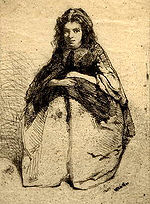
Honoré Daumier
Honoré Daumier was a French printmaker, caricaturist, painter, and sculptor, whose many works offer commentary on social and political life in France in the 19th century....
and Gavarni
Paul Gavarni
Paul Gavarni was the nom de plume of Sulpice Guillaume Chevalier , a French caricaturist, born in Paris...
, as well as in illustrations of novels about them, such as Gerald du Maurier's own engravings for Trilby. The artist and war correspondent, Constantin Guys, frequently portrayed them in his sketches of Parisian life during the Second French Empire
Second French Empire
The Second French Empire or French Empire was the Imperial Bonapartist regime of Napoleon III from 1852 to 1870, between the Second Republic and the Third Republic, in France.-Rule of Napoleon III:...
. A grisette likewise became the subject of one of Edward Hopper
Edward Hopper
Edward Hopper was a prominent American realist painter and printmaker. While most popularly known for his oil paintings, he was equally proficient as a watercolorist and printmaker in etching...
's early watercolours, painted in Paris in 1906. Hopper's portrayal, like several of those by Guys, shows the grisette wearing a traditional seamstress apron. However, their slightly raised skirts (particularly in the Guys sketches) and provocative poses also allude to the association of grisettes with prostitution.
Whistler
James McNeill Whistler
James Abbott McNeill Whistler was an American-born, British-based artist. Averse to sentimentality and moral allusion in painting, he was a leading proponent of the credo "art for art's sake". His famous signature for his paintings was in the shape of a stylized butterfly possessing a long stinger...
's arresting 1858 portrait of Fumette, his lover at the time, reflects not only his aversion to sentimentality in painting but also the character of Fumette herself, who was a rather unusual grisette. Although Whistler had dubbed her 'Fumette' in imitation of 'Musette', a character in Scènes de la vie de Bohème, her real name was Eloise. A milliner's assistant, artist's model and reciter of poetry, she was known throughout the Latin Quarter
Latin Quarter
Latin Quarter is a part of the 5th arrondissement in Paris.Latin Quarter may also refer to:* Latin Quarter , a British pop/rock band* Latin Quarter , a 1945 British film*Latin Quarter, Aarhus, part of Midtbyen, Aarhus C, Denmark...
as "the tigress" (la tigresse) for her raging voice and dangerous temper. Their ménage on the Rue Saint Sulpice lasted for two years and was a stormy one. One day in a fit of anger, she tore up a number of Whistler's drawings.
The grisette in poetry
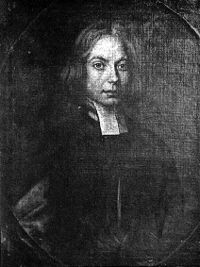
Jonathan Swift
Jonathan SwiftJonathan Swift
Jonathan Swift was an Irish satirist, essayist, political pamphleteer , poet and cleric who became Dean of St...
's To Betty, the Grisette, gives a rather jaundiced portrayal of the grisette and her intellectual pretensions. Swift's "grisette" (or "grizette" as spelled in early editions of his work) is Irish, not French, and demonstrates that the generic use of the term in English to indicate a woman of loose morals already existed by 1730. Betty is presumed to be a prostitute with whom Swift had consorted in Dublin.
Extract from To Betty, the Grisette (1730)
- ...Sets of phrases, cut and dry,
- Evermore thy tongue supply;
- And thy memory is loaded
- With old scraps from plays exploded;
- Stock'd with repartees and jokes,
- Suited to all Christian folks:
- Shreds of wit, and senseless rhymes,
- Blunder'd out a thousand times;
- Nor wilt thou of gifts be sparing,
- Which can ne'er be worse for wearing.
- Picking wit among collegians,
- In the playhouse upper regions;
- Where, in the eighteen-penny gallery,
- Irish nymphs learn Irish raillery...
Oliver Wendell Holmes Sr.
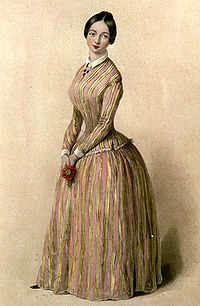
Elegiac
Elegiac refers either to those compositions that are like elegies or to a specific poetic meter used in Classical elegies. The Classical elegiac meter has two lines, making it a couplet: a line of dactylic hexameter, followed by a line of dactylic pentameter...
La Grisette, by Oliver Wendell Holmes
Oliver Wendell Holmes, Sr.
Oliver Wendell Holmes, Sr. was an American physician, professor, lecturer, and author. Regarded by his peers as one of the best writers of the 19th century, he is considered a member of the Fireside Poets. His most famous prose works are the "Breakfast-Table" series, which began with The Autocrat...
a century later. Written in 1836, shortly after he had returned to Boston
Boston
Boston is the capital of and largest city in Massachusetts, and is one of the oldest cities in the United States. The largest city in New England, Boston is regarded as the unofficial "Capital of New England" for its economic and cultural impact on the entire New England region. The city proper had...
from his medical studies in Paris, it expresses not only nostalgia for the young woman who had been his lover but also for Paris itself and all that it represented. It was a nostalgia shared by many of his American contemporaries who had studied there. Holmes' description of Clemence reflects a frequent 19th century perception of the grisette as an attentive and self-effacing companion to the starving artists and romantic students of bohemia. Her early death, alluded to in the poem, was not unusual. Many grisettes died of tuberculosis
Tuberculosis
Tuberculosis, MTB, or TB is a common, and in many cases lethal, infectious disease caused by various strains of mycobacteria, usually Mycobacterium tuberculosis. Tuberculosis usually attacks the lungs but can also affect other parts of the body...
both in real life and in their fictional portrayals, e.g. Mimi in Scènes de la vie de Bohème and Fantine in Les Misérables.
Extract from La Grisette (1836)
- Ah Clemence! when I saw thee last
- Trip down the Rue de Seine,
- And turning, when thy form had past,
- I said, "We meet again,"--
- I dreamed not in that idle glance
- Thy latest image came,
- And only left to memory's trance
- A shadow and a name.
- The few strange words my lips had taught
- Thy timid voice to speak,
- Their gentler signs, which often brought
- Fresh roses to thy cheek,
- The trailing of thy long loose hair
- Bent o'er my couch of pain,
- All, all returned, more sweet, more fair;
- Oh, had we met again!...
Mark Twain on grisettes

Mark Twain
Samuel Langhorne Clemens , better known by his pen name Mark Twain, was an American author and humorist...
's 1869 Innocents Abroad)
- Ah, the grisettes! I had almost forgotten. They are another romantic fraud. They were (if you let the books of travel tell it) always so beautiful—so neat and trim, so graceful—so naive and trusting—so gentle, so winning—so faithful to their shop duties, so irresistible to buyers in their prattling importunity—so devoted to their poverty-stricken students of the Latin Quarter—so lighthearted and happy on their Sunday picnics in the suburbs—and oh, so charmingly, so delightfully immoral!
- Stuff! For three or four days I was constantly saying:
- "Quick, Ferguson! Is that a grisette?"
- And he always said, "No."
- He comprehended at last that I wanted to see a grisette. Then he showed me dozens of them. They were like nearly all the Frenchwomen I ever saw—homely. They had large hands, large feet, large mouths; they had pug noses as a general thing, and moustaches that not even good breeding could overlook; they combed their hair straight back without parting; they were ill-shaped, they were not winning, they were not graceful; I knew by their looks that they ate garlic and onions; and lastly and finally, to my thinking it would be base flattery to call them immoral.
- Aroint thee, wench! I sorrow for the vagabond student of the Latin Quarter now, even more than formerly I envied him. Thus topples to earth another idol of my infancy.

